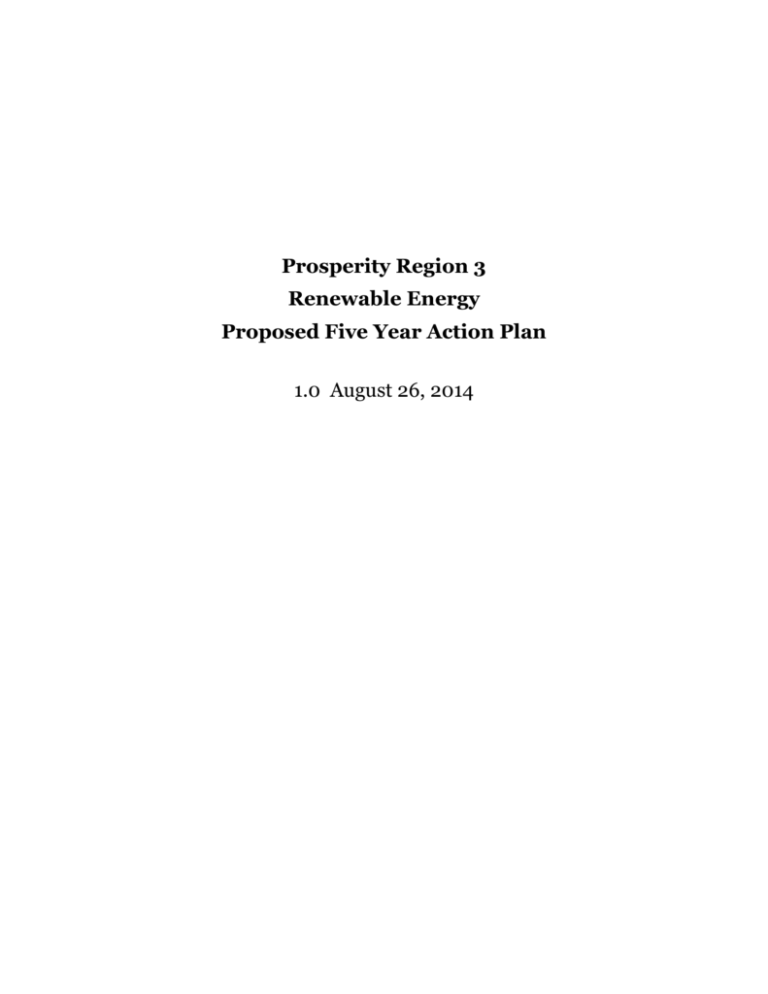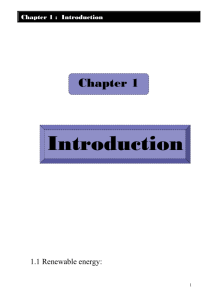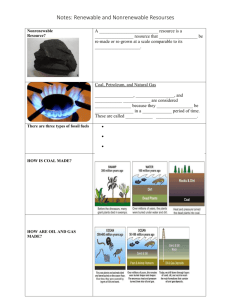Prosperity Region 3 Renewable Energy Proposed Five Year Action
advertisement

Prosperity Region 3 Renewable Energy Proposed Five Year Action Plan 1.0 August 26, 2014 Introduction The energy sector as a whole includes mainstream sources of energy – fossil fuels, hydropower, nuclear, etc. – as well as new and alternative renewable sources such as wind, solar, geothermal, biomass conversion, and other experimental technologies. Employment associated with the energy sector includes extraction, processing and delivery of fossil fuels, research and manufacturing of energy producing equipment, sales, installation, support, and maintenance of various energy systems. The high cost of energy both in residential and commercial applications justifies significant expenditures on energy efficiency, also included as a part of the energy sector. The American Council for an Energy-Efficient Economy (ACEEE) estimates potential savings of $1.2 trilling by 2020 from investment in energy efficiency, and effort that could create 1.3 to 1.9 million jobs in the US1 Energy efficiency comprises jobs and technology including mass transit, building materials and design, lighting, appliances, electric vehicles and batteries, and water management as well as a range of design, analysis, and other professional services. Energy investment and production in Region 3 range from very large scale companies – locally Consumers Energy, Presque Isle Electric and Gas Cooperative – to individuals and families assembling their own solar panels, hot water processors, and windmills. Employment in the industry likewise includes a broad range, from traditional industry positions in engineering and maintenance, to small entrepreneurs and retailers supplying a do-it-yourself market. In general, the renewable energy sector offers opportunities for significant growth. The Environment Study Institute report of June 2013 estimates approximately 1,000,000 jobs nationally in clean energy2, and forecasts significant jobs growth for the near and long term in every component of the renewable energy sector. In Region 3, renewable energy has provided some important new growth opportunities in recent years. In 2014, Alpena Biorefinery began shipping ethanol produced from byproduct of DPI, an adjacent panel processing facility, which itself uses local wood industry byproducts. Electric generation plants use wood biomass for fuel in Hillman, Grayling, and Lincoln. Wind power facilities operate in Mackinaw City and the thumb area (not quite all in Region 3, but close enough to note). New landfill gas generation facilities are in development in Montmorency County. Statistics for small-scale electric generation (e.g., for a home or business building) are not readily available, but solar panels, solar hot water systems, electric cars, and other such devices appear throughout the area. The Amish community in Mio makes significant use of off-the-grid electric generation using solar panels and diesel engines. Michigan continues to offer tax credits and net-metering opportunities that should provide the basis for increased sales, installation, and service as the efficiency of 1 http://www.renewableenergyworld.com/rea/news/article/2014/01/new-solar-job-statistics-released-but-otherrenewables-are-growing-too 2 http://www.eesi.org/papers/view/fact-sheet-jobs-in-renewable-energy-and-energy-efficiency?/fact-sheet-jobsrenewable-energy-and-energy-efficiency-11-jun-2013#2 distributed power generation systems continues to improve, and the cost continues to decline. Overview of the Renewable Energy Sector Renewable energy includes a variety of approaches to generating electricity or transportable fuels, including: Solar panels, a series of connected photovoltaic modules attached to a supporting structure; Wind power, a process of rotating turbines to drive a generator; Hydropower, a mature and mainstream technology in which water flow turns a generator turbine; Geothermal generation, which uses deep groundwater at a higher temperature to create motion that generates electricity; Biomass electric generation, in which waste products – woody biomass, landfill waste, etc. – are burned to drive a steam generator; Biomass gasification, in which the waste products are heated to create a gas, which is then burned to drive a steam generator; Biomass fuel conversion, as multistage process that converts woody biomass to ethanol or diesel fuel. New technologies and applications continue to develop, and some of the research is promising; the list above represents the major approaches in use at this time. These technologies may apply on a utility scale – an electric generation plant that feeds power into the grid – or on a more limited scale – a home, a business, a school or other public building, or a small neighborhood. In the past, power system development has focused on large-scale, interconnected plants, creating a nationwide grid with efficiencies of scale. Distributing power generation – using building scale or neighborhood scale technology – sacrifices some of the efficiencies of scale (i.e., uses more labor and creates more jobs) in return for greater independence for user. It also offers the advantages of system redundancy, as well as avoiding transportation costs of fuel (i.e., biomass) to a large centralized generating facility. In addition to generating electricity or producing fuel for a vehicle, alternative approaches may be used to create heat to warm buildings or for industrial purposes such a kilns. This process, called Combined Heat and Power (CHP) was promoted by the US Department of Energy and Environmental Protection Agency in the aftermath of the destruction of hurricane Sandy.3 In fact, electric generation processes that utilize biomass will create approximately 2.2 times as much heat as electricity. When the heat as well as the electricity can be captured for use, the overall efficiency and cost of the process becomes even more attractive. As an example, one local sawmill uses over 3 http://www1.eere.energy.gov/manufacturing/distributedenergy/pdfs/chp_for_reliability_guidance.pdf $20,000 per month in electricity. A CHP unit from Borealis Wood Power will generate all of the electricity needed plus heat to warm the buildings and dry lumber. At an estimated $325,000, the payback period on the unit could be as low as three years, depending on the value applied to residue products used. Northeast Michigan benefits from optimal utilization of all of its resources, particularly when the production process remains close to the source of materials. The renewable energy sector provides excellent opportunities for job creation, as it involves new research, innovation, and technology, and startup companies opening new markets. National Bureau of Economic Research studies demonstrate that while startup companies account for only 3 percent of total jobs in the economy, they provide almost 20 percent of total job creation.4 This includes allowance for startup failures, which remove some of the created jobs. Energy and Environmental Regulation Discussions about clean air and water, global warming, and sustainability often focus on the production, transmission, and use of energy. We replace incandescent bulbs with LEDs, not only to save money, but because we have an image of a coal-fired power plant spewing black smoke into the sky. Using less energy, and producing it with cleaner technology, represent paths to a healthier, more beautiful, and sustainable lifestyle. Recent regulations from the US Environmental Protection Agency, under section 111 of the Clean Air Act, affect carbon pollution from new and existing power plants. Section 111(b) will establish standards for new, modified, and reconstructed facilities at the federal level. Section 111(d) provides for state-based programs to meet EPA guidelines through state and regional efforts. The Clean Power Plan Proposed Rule, released in June, 2014, allows states a great deal of flexibility as they create plans to reduce carbon emissions and create a cleaner and more efficient power sector. While Region 3 is not likely to have a dominating influence on the state and regional plans, the search for renewable and clean energy presents an opportunity; we need to participate in that process and continue to gather information as it progresses over the next year. Some of the efforts – e.g., transmission line optimization, energy efficiency efforts, biomass generation, etc. – will affect Northeast Michigan. The flexibility to use “outside the fenceline” approaches opens the market for new and innovative technologies, as well as “mainstream” alternative energy. In this world, Region 3 may actually have some advantages over the traditional “smokestack” industrial areas of the Midwest. In addition, the EPA’s encouragement of interstate coordination may open markets for local products (e.g., biomass, pellets, etc.). 4 http://www.nber.org/digest/feb11/w16300.html The demand for alternative energy applications and the need for reducing the carbon footprint provide incentives for utilities and entrepreneurs to explore innovative solutions. NextEnergy has summarized a number of new approaches in a report titled “Innovation in Business Models,” including lease programs that spread the cost of renewable installations over many years, based on fixed monthly charges or kilowatt usage; renewable energy providers who retain ownership and maintenance responsibility for the equipment installed; grid-tie systems that mix utility and solar to fit their needs, again providing maintenance services; commercial solar hot water systems with leases, maintenance, and guaranteed rates; mobile generators and changeable batteries for electric vehicles, providing simpler operation and extended range; Michigan’s net metering laws establish the rules for connecting alternative energy sources to the grid, allowing business and individual consumers to choose a mix of technologies to support their needs. Net metering regulations involve some complexity, but do permit users of renewable energy systems to provide for their own usage and sell excess generated electricity back to the grid. Providing the service of completing complicated forms can seem like an obstacle to new participants in the field, but it also creates an opportunity for small entrepreneurs (as is the case, for example, with tax returns). Proposed Strategies 1. Vocational/Entrepreneurial Training Many leaders, including Michigan’s Gov. Snyder, have noted that the educational system has moved away from vocational and technological training, instead emphasizing college preparation and more “academic” subjects. While this offers advantages for some students, it also has two major disadvantages: it leaves students less prepared for work if they do not continue on to college, and it leaves gaps in the workforce for jobs that require hands-on vocational skills rather than academic coursework. Renewable energy provides excellent work opportunities, many of which do not require extensive college education. In addition to the research and design jobs, the industry will require retail outlets, parts suppliers, installers, maintenance, transportation, and customer service, as well as entrepreneurs and administrative staff. A. We should encourage our community colleges to adopt appropriate and cost effective renewable energy solutions, and to offer programs that teach the basic skills required to participate in the industry. Goal: Certificate programs in place at ACC and KCC by Fall 2016 B. Because learning takes place throughout a lifetime, we must encourage the community colleges to offer this training to adult students who wish to update their skills and move into new jobs. Goal: Certificate programs in place at ACC and KCC by Fall 2016 In addition, we must encourage businesses to participate in the lifelong learning process, offering incentives and removing impediments to apprenticeships, cooperative training, and other on-the-job training programs. Goal: Coordinated apprenticeships programs, beginning in 2015 2. Technological Infrastructure New energy sources involve a higher level of technology, far beyond moving coal into a furnace. State of the art energy systems involve equipment to monitor and optimize the process, even in and from remote locations. New regulations will almost certainly require an information gathering process that requires online interfaces. Region 3 must participate in the advancement of energy technology, and in fact, can take advantage of emerging business opportunities. In order to do that, we need to have installed the core technologies upon which modern business depends. We must provide basic technological infrastructure throughout the region to support the needs of a modern business, tools for training and education, and essential lifestyle needs and residents and tourists. Every developable area within the region must have the basic technologies to compete with other areas of the state. This includes reliable high speed internet service and wireless telephone access along all of the major routes and in all business and population centers. Goal: Complete installation of high-speed broadband internet services and wireless telephone access along all of the major routes, in all business and population centers, and in all targeted developable areas of Northeast Michigan by the end of 2015. We may accomplish this with persuasion and jawboning of private internet service providers, or it may require a combination of public and private grants. In any case, this investment in technological infrastructure must occur in order for any of the other plans and programs to be viable. 3. Distributed Energy Systems - Combined Heat and Power Systems Region 3, with its concentration of wood industry facilities, is particularly suited for installation of distributed systems to generate electricity and heat off the grid or supplementing grid system. We should work with the USDA to promote opportunities for use of wood, manufactured pellets, and CHP systems that offer clean and efficient energy. Goal: Work with USDA; one feasibility study completed by June 2015; if appropriate, install CHP prototype by end of 2015 Many families and businesses in this area heat with wood using stoves, outdoor burners, and in-floor systems. Some of the technologies used in these applications do not meet clean air standards. Upgrading or replacing those systems – using new technology to clean emissions, or replacing older systems with cleaner pellet systems – can create jobs in this area and help to meet the state’s obligations under 111(d). Goal: Establish Renewable Energy Resource Center(s) to assist in upgrades and replacement, available by June 2016. 4. Energy Planning Region 3 must continue to monitor development of 111(d) plans in Michigan and neighboring states, both to insure that our area receives the benefits of any improvements and upgrades, and to look for opportunities as new industries emerge in the renewable energy sector. Goal: Appoint at least one liaison to represent Region 3 and to work with NextEnergy to keep current on 111(d) issues and identify opportunities 5. Business Facilitation – Simplify, Streamline One of the roadblocks to doing business in rural areas involves the patchwork of rules and regulations that may vary greatly from township to township and from county to county. This is particularly true where new and unfamiliar technologies are involved. A builder in the center of our region was recently denied an occupancy permit because the inspector did not understand the technology used in the under floor heating system. The builder/owner was forced to replace the power source in order to accommodate the inspector’s lack of experience. We should assist renewable energy retailers and installers in educating the public and regulators about best practices for new technologies, guidelines and procedures for net metering, and help to insure that rules and regulations for businesses throughout the region are generally consistent, up to date, and reasonable with respect to energy systems. Goal: (see 3 above) Establish Renewable Energy Resource Center by June 2016 (Noted elsewhere.) We should undertake a study of rules and regulations for businesses throughout the region, and produce a handbook for businesses that will identify all of the agencies and offices involved. In addition, we should create a system of hotlines and ombudsmen to help new and existing businesses deal with questions and problems in the regulatory system. Our vision: Northeast Michigan should have a reputation as an outstanding place to do business. Goal: Establish a task force by March 2015, including representatives from each county in the region to complete a study of rules and regulations, offices and personnel, services and access points. Present the report by the end of 2015, including recommendations for simplifying and streamlining processes for business startup and growth. 6. Investment Almost every opportunity for maintenance and growth of existing business or establishment of new business – that is, anything that will increase employment – involves significant capital expenditure. The renewable energy sector includes new and growing companies, offering excellent opportunities for startup businesses and expansions of existing companies. The direct injection of public funds into new ventures seems unlikely in today’s economic and political environment, and violates the sensibilities of many residents of this area. Unlike some other areas of the state, Northeast Michigan does not have philanthropic deep pockets on the scale of a Wege, DeVos, Van Andel, or Prince. As we encourage public and private investments in this sector, we also need to explore creative new ways of bringing investment dollars into this region. Crowdfunding presents a new opportunity, particularly with Michigan’s new laws about intrastate equity financing. We need to develop resources for doing that well, which will require some study and expertise. Goal: Have someone with crowdfunding expertise available in Region 3 for business consultation, June 2015. Resources: Dan Radomski, Vice President, Venture & Industry Development, NextEnergy Center Roman Bukowinski, T.E.S. Solar, Tartan Energy System, LLC Jay Jacobs, Consumers Energy, West Branch http://www.borealiswoodpower.com/process.php http://www.epa.gov/chp/basic/biomass.html http://www.energyandresources.vic.gov.au/energy/sustainable-energy/bioenergy/sawmillpowered-by-wood-waste http://aesofamerica.com/biofuelproject/ http://www.ucsusa.org/assets/documents/clean_energy/Charting-Michigan-s-RenewableEnergy-Future.pdf http://www.nrdc.org/energy/renewables/michigan.asp http://www.dsireusa.org/incentives/index.cfm?re=0&ee=0&spv=0&st=0&srp=1&state=MI http://www.nrel.gov/gis/re_potential.html http://www.sustainablebusiness.com/index.cfm/go/news.display/id/23991








